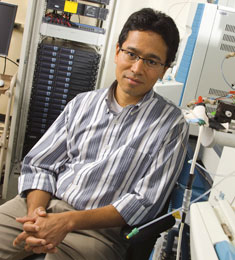Feature Story
Health Center Today, August 21, 2009
Han Lab Research Published in Science Signaling
By Chris DeFrancesco

David Han, director of the Proteomics and Biological Mass Spectrometry Core, and his research team have been analyzing how cells communicate, with implications that could forge a new path to treating disease.
Photo by Al Ferreira
How do white blood cells, or T cells, sense and interpret signals to proliferate, fight infection, or kill cancer cells?
T cells, also known as T lymphocytes, are cells that are instrumental in the development and function of the body’s immune system. They possess highly specific cell-surface antigen receptors, which means they have an affinity for substances that are foreign to the body and evoke an immune response.
Researchers in the Department of Cell Biology and Center for Vascular Biology have conducted a large-scale analysis of cell phosphorylation, or the addition of chemicals known as phosphates on specific sites of proteins when T cells receive instructions to kill pathogens. An example of this is when T cell surface proteins, called the T cell receptors (TCR), become activated. The study focuses on how phosphorylation affects the transmission of signals inside the cell, leading to the execution of complex functions such as proliferation, cell shape change, and secretion of important factors in T cells.
“When phosphate is added on specific sites of different proteins, these are instructions to do distinct function for each of the proteins,” says David Han, director of the Proteomics and Biological Mass Spectrometry Core. “This is one of the major ways in which signals get relayed, but we didn’t know how site-specific phosphorylation on many proteins influences their function.”
By identifying more than 10,000 unique phosphorylation sites on more than 3,000 proteins, the Han Lab cast a much broader net than most of the previous research done in this area.
The emerging theme from the study is that phosphorylation is widespread and targets many protein modules, and site-specific phosphorylation seems to influence proteins to interact with new proteins, or disrupt interactions that are already in place.
This new information could help clear the way for studying complex signaling networks in many cell systems including in cancer, Han says. “Treating cancer by targeting one molecule at a time has limited success, since we do not fully understand the whole signaling network that causes cancer. Using the technique of phosphoproteomics will help identify dynamic signaling networks that are operative in cancer, and likely pave the way for targeting critical proteins of the cancer signaling networks.”
Phosphoproteomics refers to a high-tech process of studying structure and function of proteins that contain a particular phosphate group.
The research is published in the Aug. 18 issue of the journal Science Signaling. An editor’s summary is available at http://stke.sciencemag.org/cgi/content/summary/sigtrans;2/84/ra46, with links to the abstract and full text of the article.
Most of the collaborators are from the Center for Vascular Biology, including lead author Viveka Mayya, Deborah Lundgren, Sun-Il Hwang, Karim Rezaul and Linfeng Wu. Vladimir Rodionov from the Berlin Center for Cell Analysis and Modeling and Jimmy Eng from the University of Washington also contributed.


